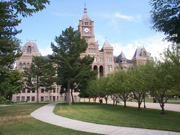Washington Square Irrigation Efficiency Demonstration Project
Historic Salt Lake City and County Building grounds to serve as focal point for efficient use of water.
Stephanie Duer, Salt Lake City Water Conservation Coordinator
July 16, 2001
|
|
The purpose of the Washington Square Project is to identify and correct specific inefficiencies in the irrigation system at Washing Square—the City & County Building—and create an educational opportunity for the community through demonstrations, printed material, and public outreach programs. The project has three components: improvements and modifications to the existing irrigation system; the installation of a central irrigation control system; and public education and information.
Improvements and modifications to the existing system begin with water checks, conducted by Utah State University Extension services. These checks identify specific problems with the irrigation system, such as misaligned or damaged sprinkler heads, incorrect water pressure, and uneven water distribution. “There are wet spots and dry spots, and some of the sprinklers over lap the road,” says Earl Jackson, the USU Extension specialist who conducted the water check. The water check will identify these problems and aid in the design of a more efficient system.
Next, a central irrigation control system will be installed. Probes that measure moisture levels will be placed in the soil in various locations and relay information to a central computer. The readings will then be compared to acceptable moisture levels and the computer will turn on only the irrigation zones that have moisture levels below acceptable levels. Those zones that are adequately moist will not be irrigated. The current irrigation control works on a calendar schedule, and activates all zones regardless of need. The new system will only water the areas that are dry; the water savings should be immediate and dramatic.
|
|
A project of this scope depends on teamwork to be successful. The departments of Public Utilities and Public Services are working together, with technical assistance from USU Extension and financial support from Central Utah Water Conservancy District (CUWCD). Rob Weyher, CUWCD Trustee, says CUWCP is pleased to be able to participate in this project because of the large number of people who visit Washington Square daily. “This project is the best opportunity for demonstrating water conservation in the valley,” Weyher said. Salt Lake City has applied for grant money for the project from the Central Utah Project – Water Conservation Credit Program, but those funds have not as yet been distributed.
Salt Lake City will demonstrate that through sound water management practices, water can be saved and beautiful, healthy landscapes can be maintained. The city will set a positive example through which it hopes to educate other large water users and the public that we can conserve water, have attractive, sustainable landscapes, and protect our future.
Additional water conservation information: http://www.slcclassic.com/utilities/saveh2o.htm

